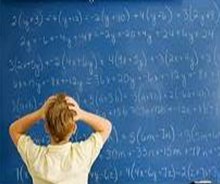
『如今,美国的数学教育引起了国人的广泛担忧。数学源于实际生活应用,但美国现行的数学课程已与生活脱节。』
How to Fix Our Math Education
如何调整美国的数学教育
August 24th 2011∣from The New York Times

THERE is widespread alarm in the United States about the state of our math education. The anxiety can be traced to the poor performance of American students on various international tests, and it is now embodied in George W. Bush’s No Child Left Behind law, which requires public school students to pass standardized math tests by the year 2014 and punishes their schools or their teachers if they do not.
All this worry, however, is based on the assumption that there is a single established body of mathematical skills that everyone needs to know to be prepared for 21st-century careers. This assumption is wrong. The truth is that different sets of math skills are useful for different careers, and our math education should be changed to reflect this fact.
Today, American high schools offer a sequence of algebra, geometry, more algebra, pre-calculus and calculus (or a “reform” version in which these topics are interwoven). This has been codified by the Common Core State Standards, recently adopted by more than 40 states. This highly abstract curriculum is simply not the best way to prepare a vast majority of high school students for life.
For instance, how often do most adults encounter a situation in which they need to solve a quadratic equation? Do they need to know what constitutes a “group of transformations” or a “complex number”? Of course professional mathematicians, physicists and engineers need to know all this, but most citizens would be better served by studying how mortgages are priced, how computers are programmed and how the statistical results of a medical trial are to be understood.
A math curriculum that focused on real-life problems would still expose students to the abstract tools of mathematics, especially the manipulation of unknown quantities. But there is a world of difference between teaching “pure” math, with no context, and teaching relevant problems that will lead students to appreciate how a mathematical formula models and clarifies real-world situations. The former is how algebra courses currently proceed — introducing the mysterious variable x, which many students struggle to understand. By contrast, a contextual approach, in the style of all working scientists, would introduce formulas using abbreviations for simple quantities — for instance, Einstein’s famous equation E=mc2, where E stands for energy, m for mass and c for the speed of light.
Imagine replacing the sequence of algebra, geometry and calculus with a sequence of finance, data and basic engineering. In the finance course, students would learn the exponential function, use formulas in spreadsheets and study the budgets of people, companies and governments. In the data course, students would gather their own data sets and learn how, in fields as diverse as sports and medicine, larger samples give better estimates of averages. In the basic engineering course, students would learn the workings of engines, sound waves, TV signals and computers. Science and math were originally discovered together, and they are best learned together now.
Traditionalists will object that the standard curriculum teaches valuable abstract reasoning, even if the specific skills acquired are not immediately useful in later life. A generation ago, traditionalists were also arguing that studying Latin, though it had no practical application, helped students develop unique linguistic skills. We believe that studying applied math, like learning living languages, provides both useable knowledge and abstract skills.
Parents, state education boards and colleges have a real choice. The traditional high school math sequence is not the only road to mathematical competence. It is true that our students’ proficiency, measured by traditional standards, has fallen behind that of other countries’ students, but we believe that the best way for the United States to compete globally is to strive for universal quantitative literacy: teaching topics that make sense to all students and can be used by them throughout their lives.
It is through real-life applications that mathematics emerged in the past, has flourished for centuries and connects to our culture now. (652words)
特别声明:①凡本网注明稿件来源为"原创"的,转载必须注明"稿件来源:育路网",违者将依法追究责任;
②部分稿件来源于网络,如有侵权,请联系我们沟通解决。
25人觉得有用
24
2011.10
海文考研英语冲刺串讲班 开班日期:2011-11-26 ~ 2011-11-27 优惠价:¥350元 课时:16......
24
2011.10
海文考研英语超级作文模板班 开班日期:2011年11月底 上课提示:共4次课,(一上午算一次课)......
24
2011.10
有效帮助考研的同学培养语感,建立良好的英语阅读环境,有助于考研英语阅读成绩的提高。 『经济危机使......
24
2011.10
『实验表明,当一些人自认为已经做了一些有益健康的事情时,即便事实并非如此,他们也会容许自己做一些......
24
2011.10
『暴乱者使用黑莓手机对付警方,警方能以其人之道,还治其人之身吗?』 Technology and disorder: ......
24
2011.10
『亚洲女性拒绝婚姻,这种现象有严肃的社会含意。』 The decline of Asian marriage:Asia's lone......